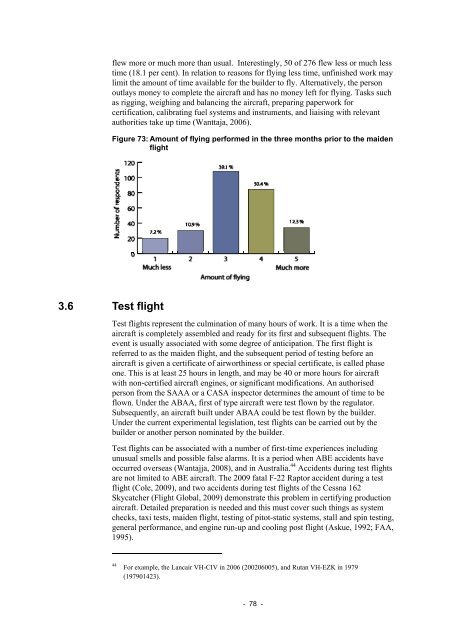Amateur-built and experimental aircraft - Australian Transport Safety ...
Amateur-built and experimental aircraft - Australian Transport Safety ...
Amateur-built and experimental aircraft - Australian Transport Safety ...
Create successful ePaper yourself
Turn your PDF publications into a flip-book with our unique Google optimized e-Paper software.
flew more or much more than usual. Interestingly, 50 of 276 flew less or much less<br />
time (18.1 per cent). In relation to reasons for flying less time, unfinished work may<br />
limit the amount of time available for the builder to fly. Alternatively, the person<br />
outlays money to complete the <strong>aircraft</strong> <strong>and</strong> has no money left for flying. Tasks such<br />
as rigging, weighing <strong>and</strong> balancing the <strong>aircraft</strong>, preparing paperwork for<br />
certification, calibrating fuel systems <strong>and</strong> instruments, <strong>and</strong> liaising with relevant<br />
authorities take up time (Wanttaja, 2006).<br />
3.6 Test flight<br />
Figure 73: Amount of flying performed in the three months prior to the maiden<br />
flight<br />
Test flights represent the culmination of many hours of work. It is a time when the<br />
<strong>aircraft</strong> is completely assembled <strong>and</strong> ready for its first <strong>and</strong> subsequent flights. The<br />
event is usually associated with some degree of anticipation. The first flight is<br />
referred to as the maiden flight, <strong>and</strong> the subsequent period of testing before an<br />
<strong>aircraft</strong> is given a certificate of airworthiness or special certificate, is called phase<br />
one. This is at least 25 hours in length, <strong>and</strong> may be 40 or more hours for <strong>aircraft</strong><br />
with non-certified <strong>aircraft</strong> engines, or significant modifications. An authorised<br />
person from the SAAA or a CASA inspector determines the amount of time to be<br />
flown. Under the ABAA, first of type <strong>aircraft</strong> were test flown by the regulator.<br />
Subsequently, an <strong>aircraft</strong> <strong>built</strong> under ABAA could be test flown by the builder.<br />
Under the current <strong>experimental</strong> legislation, test flights can be carried out by the<br />
builder or another person nominated by the builder.<br />
Test flights can be associated with a number of first-time experiences including<br />
unusual smells <strong>and</strong> possible false alarms. It is a period when ABE accidents have<br />
occurred overseas (Wantajja, 2008), <strong>and</strong> in Australia. 44 Accidents during test flights<br />
are not limited to ABE <strong>aircraft</strong>. The 2009 fatal F-22 Raptor accident during a test<br />
flight (Cole, 2009), <strong>and</strong> two accidents during test flights of the Cessna 162<br />
Skycatcher (Flight Global, 2009) demonstrate this problem in certifying production<br />
<strong>aircraft</strong>. Detailed preparation is needed <strong>and</strong> this must cover such things as system<br />
checks, taxi tests, maiden flight, testing of pitot-static systems, stall <strong>and</strong> spin testing,<br />
general performance, <strong>and</strong> engine run-up <strong>and</strong> cooling post flight (Askue, 1992; FAA,<br />
1995).<br />
44<br />
For example, the Lancair VH-CIV in 2006 (200206005), <strong>and</strong> Rutan VH-EZK in 1979<br />
(197901423).<br />
- 78 -

















